ZDF
| ZDF | |
|---|---|
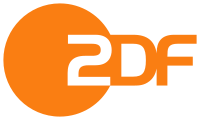 | |
| Launched | 1 April 1963 |
| Picture format |
576i (16:9 SDTV) 720p (1080p (DVB-T2 only)) (HDTV) |
| Audience share | 15.5% (July 2018, KEK) |
| Slogan | Mit dem Zweiten sieht man besser. |
| Country | Germany |
| Language | German |
| Broadcast area |
Germany; also distributed in: Austria Luxembourg Switzerland Liechtenstein Slovenia Belgium Italy Netherlands Denmark Kosovo |
| Headquarters | Mainz-Lerchenberg, Germany |
| Replaced | ARD 2 (1961–1963) |
| Sister channel(s) |
ZDFneo ZDFinfo |
| Website |
www |
Availability | |
| Terrestrial | |
| DVB-T (SD) / DVB-T2 (HD) | Various; region dependent |
| Satellite | |
| Astra 19.2°E (Europe) |
11.953 GHz Horizontal SR: 27500 FEC: 3/4 SID: 28006 Video PID: 110 Audio PID: 120 Stereo, 125 Dolby Digital |
| Astra 19.2°E (DVB-S2 HDTV) (Europe) |
11.362 GHz Horizontal SR: 22000 FEC: 2/3 SID: 11110 Video PID: 6110 Audio PID: 6120 Stereo, 6122 Dolby Digital |
| Cable | |
| Kabel Deutschland (Germany) | Channel 102 (SD) / Channel 113 (HD) |
| Unitymedia (Germany) | Channel 302 (SD) / Channel 2 (HD) |
| NetCologne (Germany) | Channel 2 (SD) / Channel 102 (HD) |
| Cablecom (Switzerland) |
Yes (SD and HD) SD – Channel 006 (digital CH-D) |
| Naxoo (Switzerland) | Channel 154 |
| Ziggo (Netherlands) | Channel 55 (HD) |
| YouSee (Denmark) | Channel 52 |
| IPTV | |
| Telekom Entertain (Germany) | Channel 2 (SD) / Channel 402 (HD) |
| A1 TV (Austria) | Channel 19 (SD) / Channel 319 (HD) |
| Streaming media | |
| ZDF.de | Watch live (Germany only) |
| FilmOn | Watch live |
| Horizon Go |
Horizon.tv (Germany only) Horizon.tv (Switzerland only) |
| Ziggo GO | ZiggoGO.tv (Netherlands only) |
Zweites Deutsches Fernsehen (German pronunciation: [ˌtsvaɪ̯təs ˌdɔʏ̯tʃəs ˈfɛɐ̯nzeːən]; English: Second German Television), usually shortened to ZDF ([ˈtsɛtˈdeːɛf]), is a German public-service television broadcaster based in Mainz, Rhineland-Palatinate. It is run as an independent nonprofit institution, which was founded by all federal states of Germany (Bundesländer). ZDF is financed by television licence fees and advertising revenues.[1]
The broadcaster is well known for its famous programmes heute, a newscast established in 1963, and Wetten, dass..? an entertainment show premiered in 1981, and ended in 2014.[2] Thomas Bellut, ZDF's director general, was elected by the ZDF Television Council in 2011.[2]
History
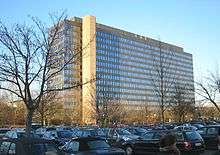
ZDF was founded in 1961 by interstate agreement, after the West German federal government's plan to set up a TV channel controlled by the federal government caused uproar. West Germany's constitution stipulated that regulation of culture and media was a compentency of the federal states (Bundesländer). The station began broadcasting from Eschborn near Frankfurt am Main on 1 April 1963, with a speech by the first director general (Intendant), Dr. Karl Holzamer. The channel broadcast its first programme in colour in 1967. In 1974, ZDF moved its base of operations to Mainz-Lerchenberg, after briefly being located in Wiesbaden. From 5 October 1996 ZDF broadcasts 24 hours a day. In 1960, the German postal service began constructing a transmitter chain for a second television network. This new network was to be broadcast on the UHF spectrum which required new reception equipment. For older receivers, a converter was sold for about 80 DM (about $20 in 1961 dollars[3] ($164 today)). As with the earlier ARD television network, the location of the transmitters was carefully planned to ensure the entire country would be able to receive the programming. To test the transmitters and encourage the public to purchase UHF receivers, the federal government allowed the ARD network to create a temporary secondary channel, ARD 2, which was broadcast daily from 8 to 10 p.m. ARD 2 began broadcasting on 1 May 1961 in the transmission area of Hessischer Rundfunk and a month later expanded nationwide.
Interstate agreement
Under the government of Konrad Adenauer, and to combat these differences between the two broadcasters, ZDF was formed in 1962 with the intention of competing with the ARD. The SPD-led states of Hamburg, Bremen, Lower Saxony, and Hesse appealed to the Federal Constitutional Court of Germany, which on 28 February 1961 in the First Broadcasting Judgment blocked the plan, declaring that all broadcasting powers belonged to the states. In March 1961, the states decided to establish, independently of existing institutions, a central nonprofit public television network. On 6 June 1961, the state premiers signed at a premiers' conference in Stuttgart the interstate agreement on the "establishment of the public institution Second German Television". On 1 December 1961, though not all states had ratified the agreement, it went into force in the states that had done so (Baden-Württemberg, North Rhine-Westphalia, Rhineland-Palatinate). The last state, Bavaria, filed the instrument of ratification on 9 July 1962.
Finances
ZDF is financed by a license fee of €17.50 per month, which must be paid by all households in Germany, except handicapped people and persons on social aid. ZDF shares the income with ARD and Deutschlandradio. The fees are not collected directly by ZDF, but by the Beitragsservice, a common organization of the ARD member broadcasters, ZDF, and Deutschlandradio. ZDF also has income from sponsorships and programming and advertising sales.
Historic Logos
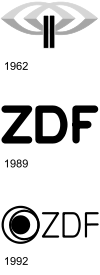
Transmission and reception
Terrestrial
As ZDF is a channel, not a network, the channel is broadcast throughout Germany, with no regional variations or affiliates, using a number of signal repeaters. ZDF transmitters broadcast a digital signal. Analog signals were gradually phased out, a process which lasted from 2002 to 2008.[4] ZDF does not run any transmitters itself. Throughout the analogue days, all ZDF transmitters were run by the Deutsche Bundespost which was later privatised as Deutsche Telekom's subsidiary T-Systems Media Broadcast. (This is in contrast to the other public German broadcaster, ARD, which owns its main transmitters.) ZDF was not previously allowed to use ARD's transmitters. ZDF has used both ARD and Telekom transmitters since changes to the law in the 1990s, and since the digital switchover.
Cable
ZDF has also been relayed by cable since the days of the first cable pilot projects.
Satellite
The first Europe-wide satellite broadcast via Astra 1C began in August 1993 during the Internationale Funkausstellung Berlin (IFA – "International Broadcasting Exhibition") in Berlin. In the same decade, these new technologies were used to enable digital broadcasting of ZDF. Today, ZDF is available free-to-air throughout Europe on Astra 19.2°E and Hot Bird (13°E).
Other ZDF channels
ZDF operates two digital channels: ZDFneo (aimed at 18-45 year olds) and ZDFinfo (documentaries). Both are transmitted in SD and HD. A commercial subsidiary called ZDF Enterprises GmbH manages programme sales, acquisitions, international coproductions, and a growing number of important activities in new media. ZDF also operates various channels in cooperation with other networks:KI.KA, Arte, 3sat, and Phoenix
Design
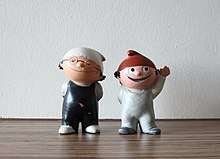
ZDF's animated station-identity mascots, the Mainzelmännchen (a play on the words "Mainz" and "Heinzelmännchen"), created by Wolf Gerlach for the channel's launch in 1963, quickly became popular and are still shown between commercials.[5] In 1976, Otl Aicher, a graphic designer, created ZDF's corporate design. A new design for ZDF was created by Lee Hunt in February 2000.
Administration
Director General
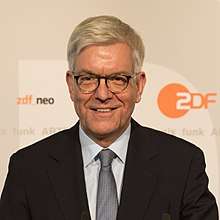
Administratively, ZDF is headed by a director general (Intendant), who is elected by the ZDF Television Council, the composition of which is in turn determined by "societally relevant groups" named in the ZDF Treaty.
Directors General since the start of ZDF:
- 1963–1977: Karl Holzamer
- 1977–1982: Karl-Günther von Hase
- 1982–2002: Dieter Stolte
- 2002–2012: Markus Schächter
- 2012–present: Thomas Bellut
Supervising board
The supervising board supervises the work of the intendant. They pay special attention to the budget. The supervising board has 14 members:
- Five representatives of the federal states
- One representative of the federal republic of Germany
- Eight independent members (not allowed to work for the government or other public entities)
Television Board
The Television Board supervises ZDF and authorizes the budget. They also elect the Director General. The board has 60 members:
- Sixteen representatives of the states of Germany
- Two representatives of the federal republic of Germany
- Two representatives of the Protestant churches
- Two representatives of the Catholic Church
- One representative of the Central Council of Jews in Germany
- 21 representatives of selected civil society groups
- 16 members nominated by the federal states, representing different social causes
Membership
ZDF became a full member of the European Broadcasting Union in 1963. It also has numerous individual cooperation agreements with broadcasters around the world. ZDF is a supporter of the Hybrid Broadcast Broadband TV initiative which promotes the establishment of an open European standard for hybrid set-top boxes for the reception of broadcast TV and broadband multimedia applications with a single user interface.
Programming[6]
Children
- 1, 2 oder 3 (1977–present)
- ALF (1988-1993)
- Alfred J. Kwak (1990-2003)
- Die Kinder von Bullerbü (Alla vi barn i Bullerbyn)
- Dog City (1995-1997)
- Fraggle Rock (Die Fraggles) (1983-1995)
- Hals über Kopf (1987-1993, 1997)
- Löwenzahn (1981–present)
- Pippi Langstrumpf (Pippi Långstrump) (1969–present)
- Rappelkiste (1973-1987)
- Tabaluga (1997-2007)
- Tabaluga tivi (1997-2011)
- The Muppet Show (Die Muppet Show) (1977-1989)
- The Simpsons (The Simpsons) (1991-1994)
Culture
- aspekte (1965–present)
- Das Blaue Sofa (2003–present)
- Das Literarische Quartett (1998–2006, 2015–present)
Documentation
- 37 Grad (1994–present)
- Die Deutschen (2008/2010)
- Terra X (1982–present)
- Terra Xpress (2011–present)
- ZDFzeit (2012–present)
- ZDF-History (2000–present)
Entertainment
- Bares für Rares, hosted by Horst Lichter (2013–present)
- Blond am Freitag (2002-2007)
- Blond am Sonntag (2001)
- Dance Academy (2010)
- Das große Los - Die Show für die Aktion Sorgenkind, hosted by Dieter Thomas Heck (1996-2000)
- Die Anstalt, comedy hosted by Claus von Wagner and Max Uthoff (2014–present)
- Die Goldene Kamera (1973, 1986, 1989, 1990, 1992, 1994–present)
- Die goldene Stimmgabel, hosted by Dieter Thomas Heck (1993, 1995, 1997, 1999, 2001-2007)
- Die größten Musical Hits (The Greatest Musical Hits)
- Die Helene Fischer Show, hosted by Helene Fischer (2013–present)
- Die Pyramide, German version of Pyramid hosted by Dieter Thomas Heck (1979-1994)
- Die Pyramide, German version of Pyramid hosted by Micky Beisenherz and Joachim Llambi (2012)
- Die ZDF-Hitparade, hosted by Dieter Thomas Heck/Viktor Worms/Uwe Hübner (1969-2000)
- Die ZDF-Kultnacht (2002–present)
- Disco (1971-1982)
- Grand Prix der Volksmusik (1986-2010)
- heute-show, comedy hosted by Oliver Welke (2009–present)
- Kerner kocht, cooking show hosted by Johannes B. Kerner (2005-2008)
- Lafer! Lichter! Lecker!, cooking show hosted by Johann Lafer and Horst Lichter (2006–2017)
- Mainz bleibt Mainz, wie es singt und lacht (Carnival) (1973–present)
- Melodien für Millionen, hosted by Dieter Thomas Heck (1985-2007)
- Musik liegt in der Luft, hosted by Dieter Thomas Heck (1991-1998)
- Neues aus der Anstalt, comedy hosted by Urban Priol (2007-2013)
- Nicht nachmachen! (2012-2013)
- Rockpop (1977–1981)
- Rock Pop Music Hall (1984-1986)
- Show Palast, hosted by Dieter Thomas Heck (1999-2000)
- Wetten, dass..?, hosted by Frank Elstner/Thomas Gottschalk (1981–2014)
- Willkommen bei Carmen Nebel, hosted by Carmen Nebel (2004–present)
- ZDF-Fernsehgarten, hosted by Andrea Kiewel (1986–present)
Information
- Aktenzeichen XY … ungelöst, hosted by Eduard Zimmermann/Sabine Zimmermann/Butz Peters/Rudi Cerne
- auslandsjournal (1973–present)
- Berlin direkt (1999–present)
- Bonn direkt (1987-1999)
- Chronik der Woche (1965-1984)
- Die Drehscheibe (1964-1982)
- drehscheibe (1998–present)
- Frontal, hosted by Bodo H. Hauser and Ulrich Kienzle (1993-2000)
- Frontal21 (2001–present)
- hallo deutschland (1997–present)
- heute (newscast) (1963–present)
- heute aus den Ländern (newscast) (1983-1992)
- heute journal (newscast) (1978–present)
- heute mittag (newscast) (1998-2009)
- heute nacht (newscast) (1994-2015)
- heute Xpress (newscast) (2015–present)
- Kennzeichen D (1971-2001)
- länderjournal (1991-1996)
- Leute heute (1997–present)
- ML Mona Lisa (1988–present)
- Politbarometer (1977–present)
- tele-illustrierte (1982-1991)
- Volle Kanne - Service täglich (1999–present)
- WISO (1984–present)
- ZDF-abendmagazin (1996-1997)
- ZDF-Magazin, hosted by Gerhard Löwenthal/Fritz Schenk/Wolfgang Weinert/Hans Scheicher (1969–1988)
- ZDF-Mittagsmagazin (1989–present)
- ZDF-Morgenmagazin (1992–present)
- ZDFzoom (2011–present)
Series
- ALF (1988-1996)
- Bella Block (1994–present)
- Blochin (2015)
- Borgia (Borgia: Faith and Fear), co-producers CANAL+ (France) and others (2011, 2013)
- The Bridge (2011), co-producers Sveriges Television and DR
- Das Kriminalmuseum (1963-1973)
- Das Traumschiff (1981–present)
- Der Adler - Die Spur des Verbrechens (Ørnen) (2005-2007, 2009-2010, 2012, 2014, 2017)
- Der Alte (The Old Fox) (1977–present)
- Der Bergdoktor (2008–present)
- Der kleine Doktor (1974, 1981-1982)
- Der Kommissar (1969–1976)
- Der Kommissar und das Meer (Kommissarien och havet) (2007–present)
- Der Kriminalist (2006–present)
- Der Landarzt (1987-2016)
- Derrick (1974–1998)
- Die Bergretter (2009–present)
- Die Chefin (2012–present)
- Die Garmisch-Cops (2012, 2014, 2016)
- Die Rosenheim-Cops (2002–present)
- Die Schwarzwaldklinik (The Black Forest Clinic) (1985-2013)
- Die Toten vom Bodensee (2014–present)
- Diese Drombuschs (1983-1995, 1998-2000)
- Dr. Klein (2014-2016)
- Ein Fall für Zwei (1981-2013)
- Ein starkes Team (1994–present)
- Forsthaus Falkenau (1989-2016)
- Freunde fürs Leben (1992-2005, 2008)
- Friesland (2015–present)
- girl friends - Freundschaft mit Herz (1995-2009)
- Helen Dorn (2014–present)
- Herzensbrecher - Vater von vier Söhnen (2013-2016)
- Highway to Heaven (Ein Engel auf Erden) (1987-1990)
- Hotel (1985, 1988)
- Hotel Paradies (1990-1992, 1995-1996, 1998, 2000-2001, 2009)
- Ich heirate eine Familie (1987-1992, 1998-2008, 2013)
- In Plain Sight (2010, 2013-2014, 2016)
- Inga Lindström (2004–present)
- Jack Holborn (miniseries for Christmas 1982)
- Jack Taylor (2013, 2017)
- Jede Menge Leben (1995-1996)
- Kidnap and Ransom (Der Jäger - Geld oder Leben) (2016–present)
- Kommissarin Lucas (2003–present)
- Kripo Holstein (2013-2015)
- Ku'damm 56 (2016)
- Küstenwache (1997-2016)
- Letzte Spur Berlin (2012–present)
- Lotta & ... (2010–present)
- Magnum, P.I. (Magnum) (2012-2015)
- Matlock (1998-1992)
- Midsomer Murders (Inspector Barnaby) (2005–present)
- Mino (1986 Christmas miniseries)
- Mordkommission Königswinkel (2017–present)
- Morgen hör ich auf (2016)
- New Tricks (New Tricks - Die Krimispezialisten) (2005)
- Notruf Hafenkante (2007–present)
- Ray Donovan (2014-2016)
- Salto Kommunale (1998, 2001-2002)
- Salto Postale (1993-1997, 2002-2003, 2006)
- Sibel&Max (2015-2016)
- Siska (2002-2010)
- SOKO 5113 (1978–present)
- SOKO Donau/SOKO Wien (2005–present)
- SOKO Hamburg (2018–present)
- SOKO Kitzbühel (2003–present)
- SOKO Köln (2003–present)
- SOKO Leipzig (2001–present)
- SOKO Rhein-Main (2006-2008, 2010)
- SOKO Stuttgart (2009–present)
- SOKO Wismar (2004–present)
- Sperling (1996-2013)
- Star Trek (Raumschiff Enterprise) (1972-1982)
- Star Trek: The Next Generation (Raumschiff Enterprise: Das nächste Jahrhundert) (1990-1993)
- Stubbe – Von Fall zu Fall (1995-2016)
- The Bold and the Beautiful (Reich und Schön) (2002-2008, 2010-2011)
- The Fall (The Fall – Tod in Belfast) (2015)
- The Five (2017)
- The Simpsons (Die Simpsons) (1991-1993)
- The Young and the Restless (Schatten der Leidenschaft) (2008)
- Unser Charly (1995-2012)
- Unsere Mütter, unsere Väter (Generation War) (2013)
- Veronica Mars (2006-2008)
- Welcome Back, Kotter (1979-1980)
- Wilsberg (1999–present)
Sport
- das aktuelle sportstudio (1963–present)
Talk
- Dunja Hayali, hosted by Dunja Hayali (2015–present)
- Johannes B. Kerner, talk show hosted by Johannes B. Kerner (1998-2009)
- live (1986-1997)
- Markus Lanz, talk show hosted by Markus Lanz (2008–present)
- Maybrit Illner, a political talk show hosted by Maybrit Illner (1999–present)
- Peter Hahne, hosted by Peter Hahne (2010–2017)
- Tacheles, hosted by Johannes Gross (1996)
- Willemsens Woche, hosted by Roger Willemsen (1994-1998)
- Zeugen des Jahrhunderts (1979–present)
Audience share
Germany
| January | February | March | April | May | June | July | August | September | October | November | December | Annual average | |
|---|---|---|---|---|---|---|---|---|---|---|---|---|---|
| 1990[7] | - | - | - | - | - | - | - | - | - | - | - | - | 28.8% |
| 1991[8] | - | - | - | - | - | - | - | - | - | - | - | - | |
| 1992[9] | - | - | - | - | - | - | - | - | - | - | - | - | |
| 1993[10] | - | - | - | - | - | - | - | - | - | - | - | - | |
| 1994[11] | - | - | - | - | - | - | - | - | - | - | - | - | |
| 1995[12] | - | - | - | - | - | - | - | - | - | - | - | - | |
| 1996[13] | 14.7% | 15.2% | 13.6% | 13.1% | 13.6% | 17.4% | 15.8% | 13.7% | 13.1% | 13.3% | 14.8% | 14.2% | |
| 1997[14] | 14.6% | 14.6% | 13.4% | 12.4% | 12.8% | 12.9% | 12.7% | 13.2% | 13.3% | 12.4% | 13.7% | 14.4% | |
| 1998[15] | 13.9% | 15.3% | 13.0% | 12.3% | 12.5% | 17.4% | 14.2% | 12.8% | 12.1% | 13.1% | 13.1% | 13.3% | |
| 1999[16] | 14.2% | 14.3% | 14.0% | 12.4% | 12.1% | 12.6% | 13.2% | 12.6% | 12.0% | 13.0% | 13.4% | 13.8% | |
| 2000[17] | 14.2% | 13.8% | 13.4% | 11.6% | 12.3% | 15.3% | 13.7% | 13.3% | 13.0% | 12.7% | 12.8% | 13.2% | |
| 2001[18] | 13.2% | 13.3% | 13.1% | 11.3% | 11.7% | 12.2% | 14.2% | 13.7% | 12.5% | 13.5% | 13.8% | 13.8% | |
| 2002[19] | 14.4% | 15.5% | 13.4% | 12.4% | 12.7% | 16.4% | 13.9% | 14.1% | 12.3% | 13.1% | 13.2% | 13.9% | |
| 2003[20] | 13.9% | 13.6% | 13.7% | 12.5% | 12.3% | 12.5% | 13.9% | 13.5% | 12.3% | 13.0% | 13.2% | 13.7% | |
| 2004[21] | 14.1% | 13.9% | 12.9% | 12.5% | 12.5% | 14.8% | 15.1% | 15.9% | 12.8% | 12.7% | 12.9% | 13.9% | |
| 2005[22] | 14.0% | 14.2% | 13.7% | 13.4% | 12.7% | 13.7% | 14.0% | 13.2% | 13.3% | 12.9% | 13.2% | 13.6% | |
| 2006[23] | 13.2% | 14.4% | 13.6% | 13.1% | 12.3% | 16.9% | 15.7% | 12.4% | 12.4% | 12.5% | 13.3% | 13.5% | |
| 2007[24] | 14.2% | 13.5% | 13.0% | 12.0% | 12.1% | 12.5% | 12.6% | 12.3% | 12.5% | 12.8% | 13.2% | 13.4% | |
| 2008[25] | 13.5% | 12.9% | 13.4% | 12.2% | 11.6% | 17.6% | 12.1% | 13.6% | 12.3% | 12.7% | 12.8% | 12.9% | |
| 2009[26] | 14.3% | 13.2% | 12.7% | 12.0% | 11.7% | 12.5% | 11.9% | 12.6% | 12.3% | 12.2% | 11.7% | 12.6% | |
| 2010[27] | 13.1% | 13.8% | 12.5% | 11.3% | 11.9% | 16.7% | 13.7% | 11.9% | 11.4% | 12.4% | 11.7% | 12.3% | |
| 2011[28] | 12.9% | 13.0% | 13.0% | 11.7% | 11.3% | 12.0% | 12.9% | 10.7% | 11.4% | 11.7% | 11.9% | 12.5% | |
| 2012[29] | 12.6% | 12.7% | 12.5% | 11.1% | 12.1% | 15.5% | 12.8% | 13.0% | 11.3% | 12.5% | 12.0% | 12.7% | |
| 2013[30] | 13.6% | 13.5% | 13.1% | 12.9% | 12.9% | 12.0% | 12.2% | 12.5% | 12.8% | 12.7% | 12.7% | 12.5% | |
| 2014[31] | 13.4% | 15.1% | 12.3% | 12.7% | 12.0% | 17.6% | 14.8% | 11.6% | 12.5% | 12.3% | 12.3% | 12.7% | |
| 2015[32] | 14.2% | 12.9% | 12.8% | 12.2% | 12.1% | 12.7% | 12.3% | 12.1% | 12.1% | 12.0% | 12.1% | 12.3% | |
| 2016[33] | 13.2% | 12.6% | 12.9% | 12.6% | 12.0% | 17.1% | 13.3% | 14.3% | 11.9% | 11.9% | 12.4% | 12.5% | |
| 2017[34] | 13.9% | 13.3% | 13.0% | 12.5% | 12.6% | 13.2% | 13.0% | 13.1% | 12.9% | 12.4% | 13.5% | 13.1% | 13.0% |
| 2018[35] | 14.1% | 14.6% | 13.9% | 13.4% | 13.1% | 16.9% | 15.5% |
The average age of the viewers is 62 years (as of 2016).[36]
References
- ↑ "European Benchmarking: Public Service Broadcasters in the Digital Era" (PDF). Circom Regional. May 2002. p. 46. Archived from the original (PDF) on 9 October 2009. Retrieved 19 July 2009.
- 1 2 "ZDF Unternehmen".
- ↑ "Historical US Dollars to German Marks currency conversion". UC Santa Barbara History Department. Retrieved 24 October 2013.
- ↑ "ZDF.com".
- ↑ "ZDF Mainzelmännchen".
- ↑ "Wunschliste". wunschliste.de. Retrieved 30 May 2017.
- ↑ "KEK/Zuschaueranteile 1990" (PDF). kek-online.de. Archived from the original (PDF) on 8 December 2015. Retrieved 11 August 2017.
- ↑ "KEK/Zuschaueranteile 1991" (PDF). kek-online.de. Archived from the original (PDF) on 8 December 2015. Retrieved 11 August 2017.
- ↑ "KEK/Zuschaueranteile 1992" (PDF). kek-online.de. Archived from the original (PDF) on 8 December 2015. Retrieved 11 August 2017.
- ↑ "KEK/Zuschaueranteile 1993" (PDF). kek-online.de. Archived from the original (PDF) on 8 December 2015. Retrieved 11 August 2017.
- ↑ "KEK/Zuschaueranteile 1994" (PDF). kek-online.de. Archived from the original (PDF) on 8 December 2015. Retrieved 11 August 2017.
- ↑ "KEK/Zuschaueranteile 1995" (PDF). kek-online.de. Archived from the original (PDF) on 8 December 2015. Retrieved 11 August 2017.
- ↑ "KEK/Zuschaueranteile 1996" (PDF). kek-online.de. Retrieved 11 August 2017.
- ↑ "KEK/Zuschaueranteile 1997" (PDF). kek-online.de. Retrieved 11 August 2017.
- ↑ "KEK/Zuschaueranteile 1998" (PDF). kek-online.de. Retrieved 11 August 2017.
- ↑ "KEK/Zuschaueranteile 1999" (PDF). kek-online.de. Retrieved 11 August 2017.
- ↑ "KEK/Zuschaueranteile 2000" (PDF). kek-online.de. Retrieved 11 August 2017.
- ↑ "KEK/Zuschaueranteile 2001" (PDF). kek-online.de. Retrieved 11 August 2017.
- ↑ "KEK/Zuschaueranteile 2002" (PDF). kek-online.de. Retrieved 11 August 2017.
- ↑ "KEK/Zuschaueranteile 2003" (PDF). kek-online.de. Archived from the original (PDF) on 11 August 2017. Retrieved 11 August 2017.
- ↑ "KEK/Zuschaueranteile 2004" (PDF). kek-online.de. Archived from the original (PDF) on 11 August 2017. Retrieved 11 August 2017.
- ↑ "KEK/Zuschaueranteile 2005" (PDF). kek-online.de. Archived from the original (PDF) on 8 December 2015. Retrieved 11 August 2017.
- ↑ "KEK/Zuschaueranteile 2006" (PDF). kek-online.de. Retrieved 11 August 2017.
- ↑ "KEK/Zuschaueranteile 2007" (PDF). kek-online.de. Retrieved 11 August 2017.
- ↑ "KEK/Zuschaueranteile 2008" (PDF). kek-online.de. Retrieved 11 August 2017.
- ↑ "KEK/Zuschaueranteile 2009" (PDF). kek-online.de. Retrieved 11 August 2017.
- ↑ "KEK/Zuschaueranteile 2010" (PDF). kek-online.de. Retrieved 11 August 2017.
- ↑ "KEK/Zuschaueranteile 2011" (PDF). kek-online.de. Retrieved 11 August 2017.
- ↑ "KEK/Zuschaueranteile 2012" (PDF). kek-online.de. Archived from the original (PDF) on 11 August 2017. Retrieved 11 August 2017.
- ↑ "KEK/Zuschaueranteile 2013" (PDF). kek-online.de. Archived from the original (PDF) on 4 March 2016. Retrieved 11 August 2017.
- ↑ "KEK/Zuschaueranteile 2014" (PDF). kek-online.de. Archived from the original (PDF) on 7 February 2016. Retrieved 11 August 2017.
- ↑ "KEK/Zuschaueranteile 2015" (PDF). kek-online.de. Archived from the original (PDF) on 17 May 2017. Retrieved 11 August 2017.
- ↑ "KEK/Zuschaueranteile 2016" (PDF). kek-online.de. Retrieved 11 August 2017.
- ↑ "KEK/Zuschaueranteile 2017" (PDF). kek-online.de. Retrieved 5 December 2017.
- ↑ "KEK/Zuschaueranteile 2018" (PDF). kek-online.de. Retrieved 25 August 2018.
- ↑ Mantel, Uwe (14 March 2017). "Langzeit-Entwicklung des TV-Markts: Wie die Sender gealtert sind - und wer sich dagegen stemmt". dwdl.de. Retrieved 3 November 2017.
External links
| Wikimedia Commons has media related to ZDF. |
- Official website (in German)
- Official website (in English)
- ZDF on IMDbPro (subscription required)